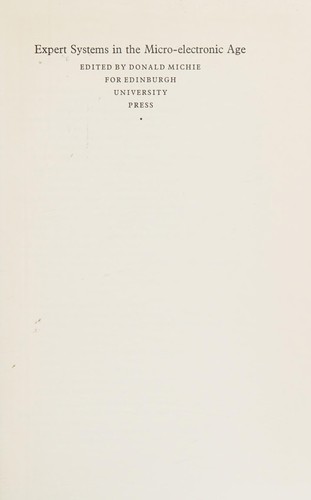Thoughts on reading Expert Systems in the Micro-Electronic Age edited by Donald Michie.

This collection of works assembled by Donal Michie serves now as an insightful exploration of the Artificial Intelligence milieu of the 1980s. Michie organizes this collection into six topics: Rule-based Systems, Special-purpose Problem solvers, Knowledge-handling Formalisms, Probabilistic and Logical Induction Systems, Expert Systems for Teaching, and Epistemological Problems of Artificial Intelligence.
The first two topics, Rule-based Systems and Special-purpose Problem solvers, appear to be the most dated, relying on context and heuristic based decision making that is at odds with the methods of Machine Learning and the Generative AI that now dominated the Artificial Intelligence landscape. That being said, I found ideas presented in the first paper, Themes and Case Studies of Knowledge Engineering, written by Edward A. Feigenbaum, pertinent. Feigenbaum quotes his earlier work with Buchanan and Lederberg, On Generality and Problem Solving: a Case Study Using Dendral Program - “ … General problem solvers are too weak to be used as the basis for building high-performance systems. The behavior of the best general problem-solver we know, human problem solvers, is observed to be weak and shallow,except in the areas in which the human problem-solver is a specialist” - which is followed by- “Experience has also taught us that much of this knowledge is private to the expert, not because he is unwilling to share publicly how he performs, but because he is unable” (pg 7). Tabeling this discussion on the obtuseness of gendered pronouns (an issue throughout the book, and the decade, and the millennium, ect.), this line of thought misses the forest for the trees on the power and desire for general AI, but precisely describes a most pressing issues with general intelligence plaguing the current Machine Learning landscape: can an intelligence determine and concisely describe the reasoning behind each of its decisions?
The middle two topics, Knowledge-handling Formalisms and Probabilistic and Logical Induction Systems, were less relevant to me and quite frankly a slog to get through: the first topic about low order logic and the second pedantic descriptions of induction rules.
The last two topics, Expert Systems for Teaching and Epistemological Problems of Artificial Intelligence, I found to be the most interesting.
The penultimate section, the shortest in the book, discusses the design and construction of AI based tools to assist classroom teaching. In Learning Through Model Building by J.A.M Howe, the author offers in detail drawbacks and obstacles of replacing teachers with machine and proposes to discuss using AI as a tool: “Instead of talking about expert systems, we want to talk about systems which the experts, i.e. teachers, can use as a resource to help them achieve their objectives, e.g. teach maths, physics, literary style and so on” (pg 215). Forty years later, this empowerment of teachers appears modern, and strikingly reflects the importance of human teaching and the potential machines can bring to make that teaching more efficient.
I became inspired to read this book after I stumbled on The Naive Physics Manifesto by Patrick J. Hayes, in the ultimate section, doing literature review for my SULI paper in the summer of 2022. Hayes’ work captivated me, especially the idea of Histories, which he proposes as a bedrock of Naive Physics. As some background, Hayes’ Naive Physics is a proposal “To construct a formalisation of a large part of ordinary everyday knowledge of the physical world … [which] should have the following characteristics … (i) Thoroughness … (ii) Fidelity … (iii) Density … (iv) Uniformity” (pgs 242-243). In essence, Hayes proposes to construct a framework that represents naive human knowledge, understanding that modern physics does not adequately capture the powers of human intuition that tend to dictate our lives. Haye’s then proposes the idea of a history, as a rejection of “the now classical approach to describing actions and change … to use the concept of state or situation” , where history is “Such an object, viz. A connected piece of space-time, typically bounded on all four dimensions, in which ‘something happens’” (pg 257). The entanglement of time and space particularly enhanced me; segmenting a life into histories forces reconciliation between detail and perspective, a universal fight as we search for nuance in periods of immense internal and social growth.